Meaning of Makar Sankranti: Makar Sankranti is a Hindu festival celebrated in almost all parts of India, Nepal and Bangladesh in many cultural forms. It is a harvest festival that falls on the Magh month of the Nepali calendar (Hindu Solar Calendar). Let’s find what is Makar Sankranti and how to celebrate Makar all over the country. Also about Makar Sankranti celebration and its other names.
1) Andhra Pradesh and Telangana
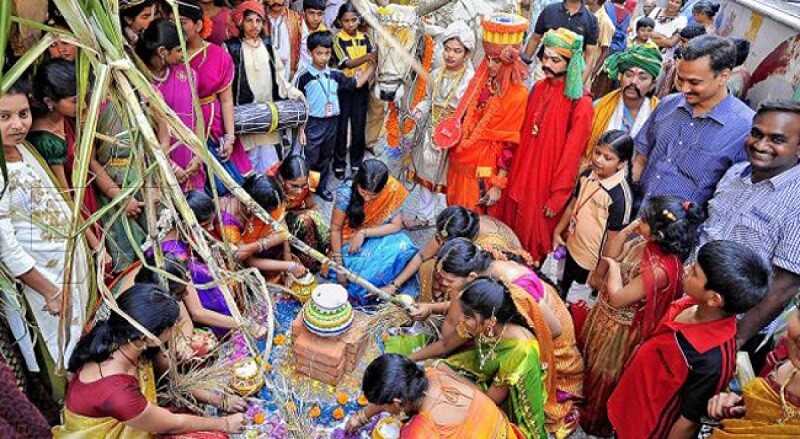
The Makar Sankranti celebration takes for four days in Andhra Pradesh and Telangana.
Day 1 – Bhoghi , Day 2 – Makara Sankranti, Day 3 – Kanum, Day 4 — Mukkanuma
In many families, infants and children (usually less than three years old) are showered with the Indian jujube fruit Ziziphus mauritiana, called “Regi Pandlu” in Telugu. It is believed that doing this protects the children from the evil eye. Sweets in generous quantities are prepared and distributed. It is a time for families to congregate. Brothers pay special tribute to their married sisters by giving gifts as affirmation of their filial love. Landlords give gifts of food, clothes and money to their workforce. The second day is Makara Sankranti. People wear new clothes, pray to God, and make offerings of traditional food to ancestors who have died. They also make beautiful and ornate drawings and patterns on the ground with chalk or flour, called “Muggu” or “Rangoli” in Telugu, in front of their homes.
On the third day, Kanuma is celebrated. Kanuma is very intimate to the hearts of farmers because it is the day for praying and showcasing their cattle with honor. Cattle are the symbolic indication of prosperity. The fourth day is called Mukkanuma which is popular among the non-vegetarians of the society. On this day, farmers offer prayers to the elements (like soil, rain, fire for helping the harvest) and the (village) goddesses with their gifts which sometimes (and these days mainly) include animals.
2) Bihar and Jharkhand
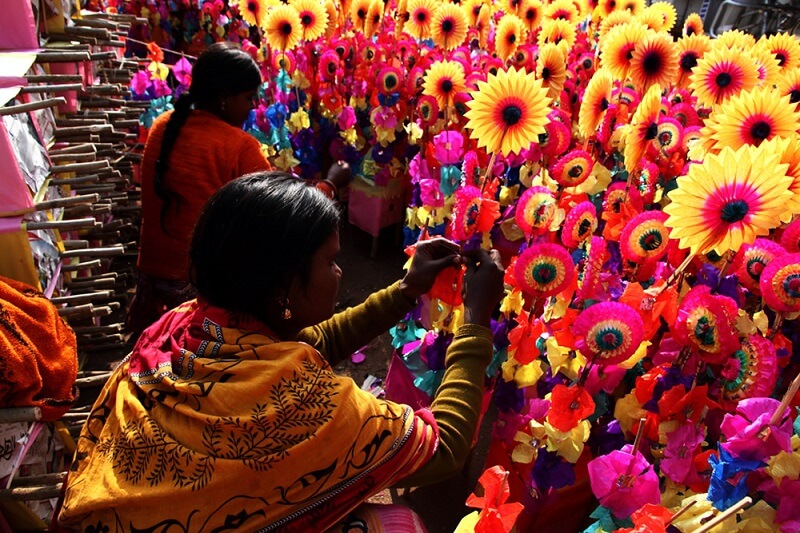
In Bihar and Jharkhand, the festival is celebrated on 14–15 January.
On 14 January, it is celebrated as Makar Sankranti or Sakraat or Khichdi (in local dialects). As in other parts of country, people take baths in rivers and ponds and feast upon seasonal delicacies as a celebration of good harvest. The delicacies include chura, gur (jaggery), sweets made of til (sesame seeds) such as tilgul, tilwa, maska, etc., curd, milk and seasonal vegetables. Kite flying festivals are organised, albeit on a small scale.
On 15 January, it is celebrated as Makraat (in some parts of the state) when people relish special khichdi (dal-rice replete with cauliflower, peas and potatoes).
3) Delhi and Haryana
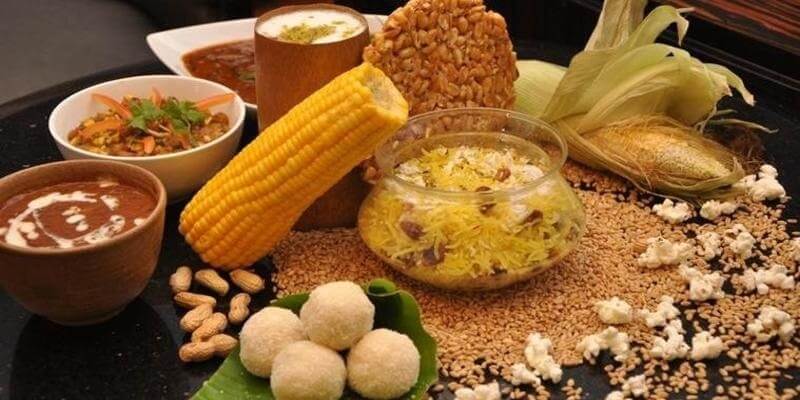
Yadavs, Jats and other rural communities of Delhi and Haryana and many neighbouring states consider Sakraat or Sankranti to be a main festival of the year. Churma of ghee, halwa and kheer are cooked specially in Jats and Yadavs homes on this day. One brother of every married woman visits her home with a gift of some warm clothing for her and her husband’s family. It is called “Sidha”. Women used to give a gift to their in-laws, and this rituals called “Manana”. The recipient will sit in a haweli (main palace where men sit together and share hookka). Women go to haweli to sing folk songs and give gifts.
4) Goa

Celebrations in Goa closely resemble to that in Maharashtra. The women celebrate ‘haldi-kumkum’.
5) Gujarat

Uttarayan, as Makara Sankranti is called in Gujarati, is a major festival in the state of Gujarat which lasts for two days.14 January is Uttarayan15 January is Vasi-Uttarayan (Stale Uttarayan) especially in Surat.
Gujarati people keenly await this festival to fly kites, called ‘patang’. Kites for Uttarayan are made of special light-weight paper and bamboo and are mostly rhombus shaped with central spine and a single bow. The string often contains abrasives to cut down other people’s kites.
In Gujarat, from December through to Makara Sankranti, people start enjoying Uttarayan. Undhiyu (spicy, baked mix of winter vegetables) and chikkis (made from til (sesame seeds), peanuts and jaggery) are the special festival recipes savoured on this day.
6) Himachal Pradesh
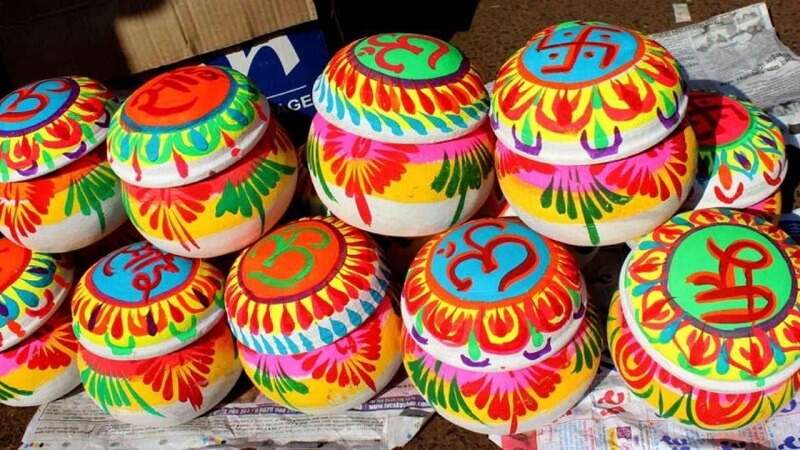
In Shimla District of Himachal Pradesh, Makara Sankranti is known as Magha Saaji. According to Hindu religious texts, on the day of Uttarayani the sun enters the zodiac sign of Makara (Capricon), i.e., from this day onwards the sun becomes ‘Uttarayan’ or it starts moving to the north. It is said that from this day, which signals a change of season, the migratory birds start returning to the hills. On Magha Saaja people wake up early in the morning and take ceremonial dips and shower in the springs or baolis. In the daytime people visit their neighbours and together enjoy khichdi with ghee and chaas and give it in charity at temples. Festival culminates with singing and Naati (folk dance).
7) Karnataka

This is the Suggi or harvest festival for farmers of Karnataka. On this auspicious day, girls wear new clothes to visit near and dear ones with a Sankranti offering in a plate and exchange the same with other families. This ritual is called “Ellu Birodhu.” Here the plate would normally contain “Ellu” (white sesame seeds) mixed with fried groundnuts, neatly cut dry coconut and fine cut bella (jaggery). The mixture is called “Ellu-Bella”. The plate contains shaped sugar candy moulds (Sakkare Acchu) with a piece of sugarcane. There is a saying in Kannada “ellu bella thindu olle maathadi” (similar to the saying tilgul kha aani god bola in Maharashtra) that translates to ‘eat the mixture of sesame seeds and jaggery and speak only good.’ This festival signifies the harvest of the season, since sugarcane is predominant in these parts. Ellu Bella, Ellu Unde, bananas, sugarcane, red berries, haldi and kumkum and small gift items useful in everyday lives are often exchanged among women in Karnataka similar to the tradition in Maharashtra.
8) Kerala

Makara Sankranti is celebrated in Kerala at Sabarimala where the Makara Jyothi is visible followed by the Makaravilakku celebrations.
9) Kumaon (Uttarakhand)
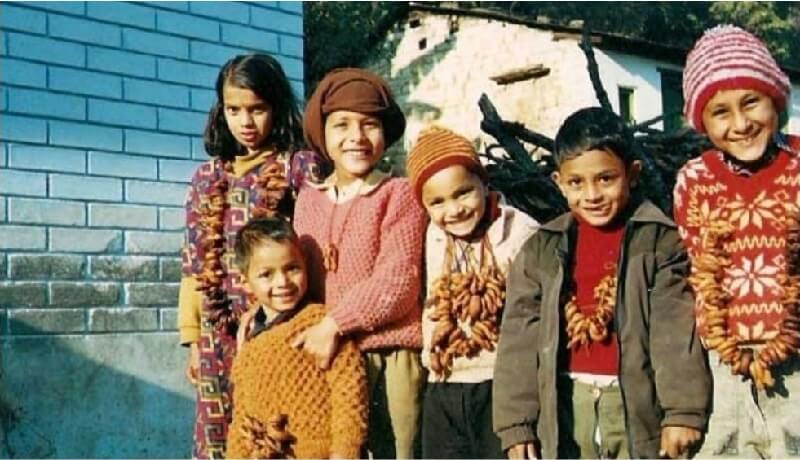
According to Hindu religious texts, on the day of Uttarayani also called Ghughuti (घुघुति) in Kumaon, the sun enters the Zodiacal sign of ‘Makara’ (Capricon), i.e. from this day onwards the sun becomes ‘Uttarayan’ or it starts moving to the north. It is said that from this day, which signals a change of season, the migratory birds start returning to the hills. On Makara Sankranti people give Khichadi (a mixture of pulses and rice) in charity, take ceremonial dips in holy rivers, participate in the Uttarayani fairs and celebrate the festival of Ghughutia or Kale Kauva. During the festival of Kale Kauva (literal translation ‘black crow’) people make sweetmeats out of sweetened flour (flour and gur) deep fried in ghee, shape them in shapes such as drums, pomegranates, knives, and swords. Early in the morning children wear these necklaces and sing “Kale Kauva” to attract crows and other birds and offer them portions of these necklaces, as a token of welcome for all the migratory birds, who are now coming back after their winter sojourn in the plains.
10) Rajasthan

“Makar Sankrati” or “Sankrat” in the Rajasthani language is one of the major festivals in the state of Rajasthan. The day is celebrated with special Rajasthani delicacies and sweets such as pheeni (either with sweet milk or sugar syrup dipped), til-paati, gajak, kheer, ghevar, pakodi, puwa, and til-laddoo.Specially, the women of this region observe a ritual in which they give any type of object (related to household, make-up or food) to 13 married women. The first Sankranti experienced by a married woman is of significance as she is invited by her parents and brothers to their houses with her husband for a big feast. People invite friends and relatives (specially their sisters and daughters) to their home for special festival meals (called as “Sankrant Bhoj”). People give out many kind of small gifts such as til-gud (jaggery), fruits, dry khichadi, etc. to Brahmins or the needy ones.
11) Odisha
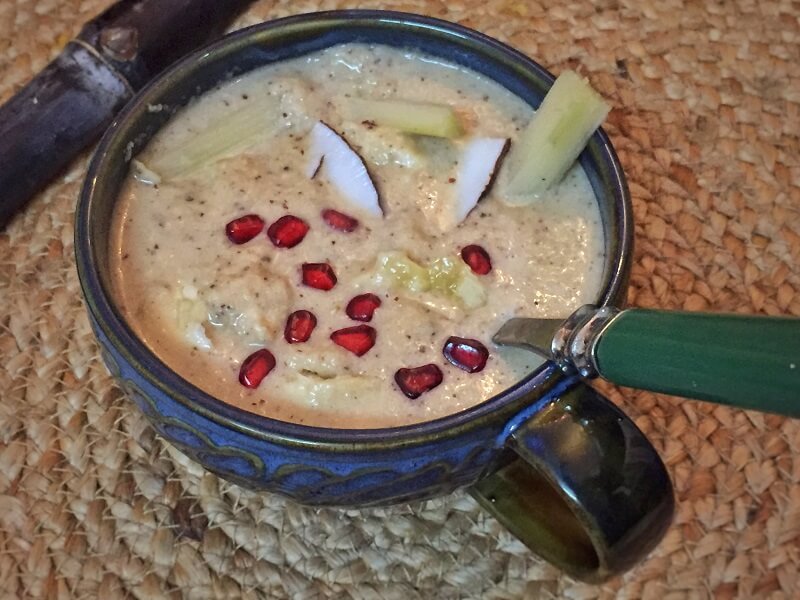
In Odisha people prepare makara chaula : uncooked newly harvested rice, banana, coconut, jaggery, sesame, rasagola, Khai/Liaa and chhena puddings for naivedya to gods and goddesses. The withdrawing winter entails a change in food habits and intake of nourishing and rich food. Therefore, this festival holds traditional cultural significance. It is astronomically important for devotees who worship the sun god at the great Konark temple with fervour and enthusiasm as the sun starts its annual swing northwards.[4] According to various Indian calendars, the Sun’s movement changes and the days from this day onwards become lengthier and warmer and so the Sun-God is worshiped on this day as a great benefactor.
12) Punjab
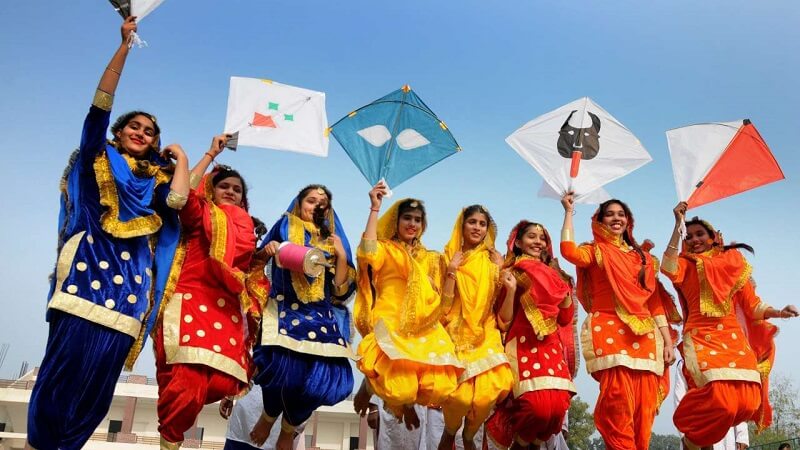
In Punjab, Makar Sankranti is celebrated as Maghi. Bathing in a river in the early hours on Maghi is important. Hindus light lamps with sesame oil as this is supposed to give prosperity and drive away all sins. The Punjabis dance their famous “bhangra”. Then they sit down and eat the sumptuous food that is specially prepared for the occasion. It is traditional to eat “kheer”, rice cooked in milk and sugarcane juice. It is also traditional to consume khichdi and jaggery.
December and January are the coldest months of the year in the Punjab. Maghi represents the change of the season to warmer temperatures and increase in daylight. Huge bonfires are lit on the eve of Maghi and the day is celebrated as Lohri.
13) Maharashtra
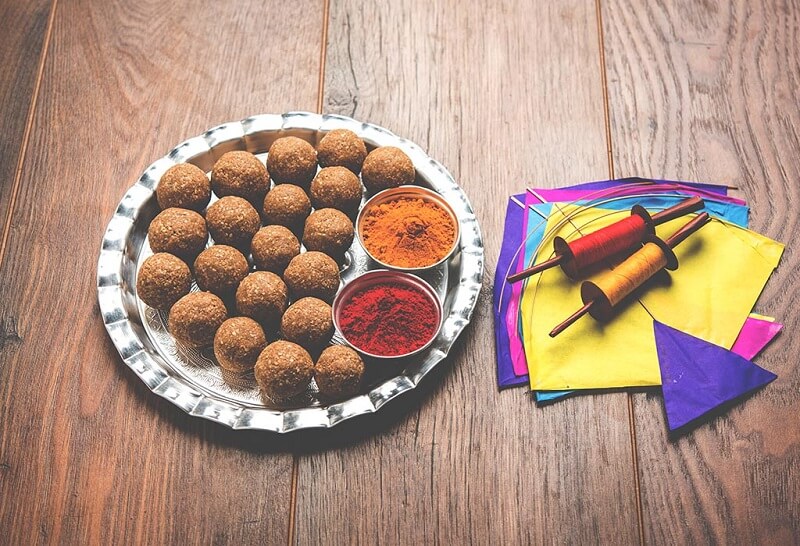
In Maharashtra on Makara Sankranti day people exchange multicoloured halwa (sugar granules coated in sugar syrup) and til-gul laadoo (sweetmeats made from sesame seeds and jaggery). Gulachi poli/puran poli (flat bread stuffed with soft/shredded jaggery mixed with toasted, ground til [white sesame seeds]) and some gram flour, which has been toasted to golden in pure ghee, are offered for lunch
This is a special day for the women in Maharashtra when married women are invited for a get-together called ‘Haldi-Kunku’ and given gifts such as utensils, clothes etc. Typically, women wear black sarees or black colored outfits on this occasion. The significance of wearing black is that Sankranti comes at the peak of the winter season and black color retains and absorbs heat, helping keep warm.[citation needed] Maharashtra is also famous for kite flying on this special occasion.
14) Tamil Nadu
It is a four-day festival in Tamil Nadu.
Day 1: Bhogi Pandigai ,Day 2: Makara Sankaranthi or Thai Pongal,Day 3: Maattu Pongal,Day 4: Kaanum Pongal
The first day of festival is Bhogi . It is celebrated by throwing away and destroying old clothes and materials, by setting them on fire.
The second day of festival is Thai Pongal or simply Pongal. It is the main day of the festival, falling on the first day of the Tamil month Thai which starts with the solar cycle when sun starts moving through the summer solstice. It is celebrated by boiling rice with fresh milk and jaggery in new pots, which are later topped with brown sugar, cashew nuts and raisins early in the morning and allowing it to boil over the vessel.
The third day of festival is Maattu Pongal. It is for offering thanks to cattle, as they help farmers in agriculture. On this day the cattle are decorated with paint, flowers and bells. They are allowed to roam free and fed sweet rice and sugar cane.
The fourth day of the festival is Kaanum Ponga. During this day people visit their relatives, friends to enjoy the festive season. It is a day to thank relatives and friends for their support in the harvest.
15) Uttar Pradesh
In Hindu Religion this is the first of the big bathing days. Over two million people gather at their respective sacred places for this holy bathing such as Allahabad and Varanasi in Uttar Pradesh and Haridwar in Uttarakhand.
first they bathe then they eat sweets such as til ladoo and gud laddo.
Kite flying is an inevitable part of the festival in Uttar Pradesh, as with many states of India such as Gujarat and Maharashtra.
16) West Bengal
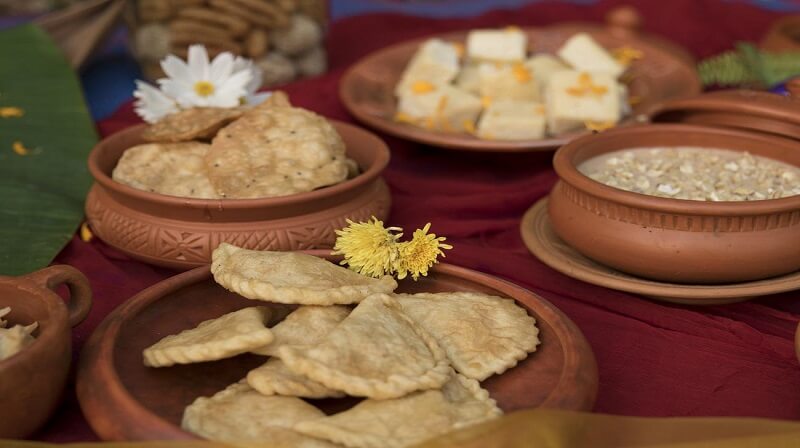
In West Bengal, Sankranti, also known as Poush Sankranti named after the Bengali month in which it falls (last date of that month), is celebrated as a harvest festival Poush Parbon. All sections of society participate in a three-day begins on the day before Sankranti and ends on the day after. The Goddess Lakshmi is usually worshipped on the day of Sankranti. In the Himalayan regions of Darjeeling, the festival is as known as Magey Sakrati. It is distinctly associated with the worship of Lord Shiva. Traditionally, people were required to take a bath before sunrise and then commence their pooja. The food that is consumed consists primarily of sweet potatoes.
Makar sankranti is not only celebrated in India But also in other countries
17)Nepal
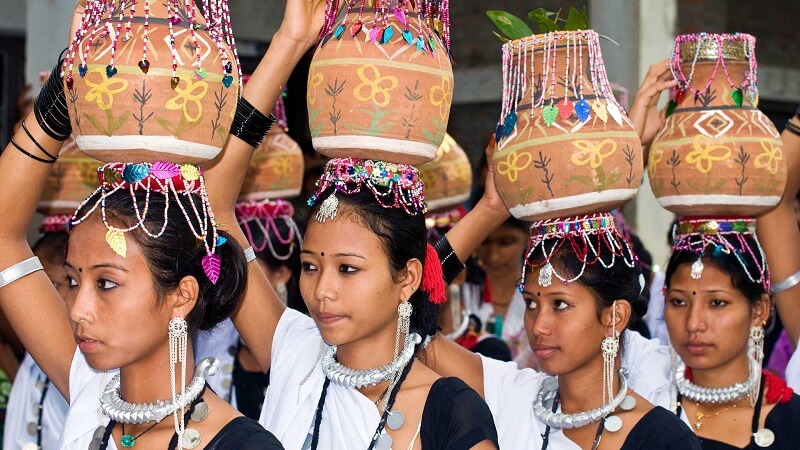
Maghe Sankranti is a Nepalese festival observed on the first of Magh in the Bikram Samwat Nepali calendar (about 14 January), bringing an end to the ill-omened month of Poush when all religious ceremonies are forbidden. On this day, the sun is believed to leave its southernmost position and begin its northward journey. Maghe Sankranti is similar to solstice festivals in other religious traditions.
Makar Sankranti history says, according to Mahabharata, Bhishma, who had the power to control his own death, chose to die on the day of Maghe Sakranti. Therefore, it is believed that one who dies on this day might achieve Moksha, a release from rebirth cycle. This is the short Makar Sankranti story.
we as Indians, do not want any reason for celebrating Makar Sankranti. We celebrate every day as festivals.
Thanks for reading this.
Happy Makar Sankranti to all of you.
Source : Wikipedia, Google.


